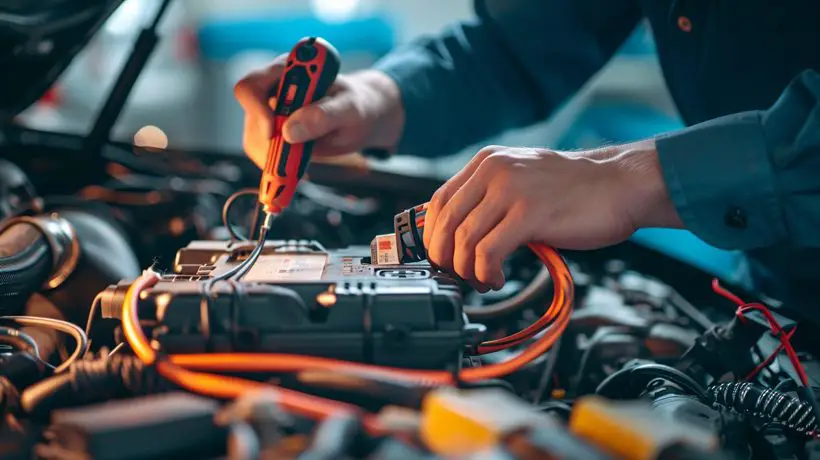Dealing with intermittent electrical issues in your car can feel like chasing shadows. One minute everything’s running smoothly, and the next, you’re left scratching your head as your dashboard lights flicker like a haunted house. It’s frustrating, but I’m here to help you track down those elusive gremlins and get back to a reliable ride.
I’ve been in the trenches with my fair share of mysterious car troubles. Let me guide you through the maze of wires and circuits to find and fix those sneaky electrical problems. With a bit of patience and the right approach, we’ll have your car’s gremlins running for the hills.
Understanding Intermittent Electrical Problems
Intermittent electrical issues are the cryptic messages your car sends when something’s not quite right. It’s like your car is trying to tell you there’s a problem, but it’s speaking in riddles. These problems can manifest as random glitches that disappear before a pattern can be identified, making diagnosis a challenge.

The Nature of Intermittent Issues
What sets intermittent electrical problems apart is their inability to maintain consistency. Unlike continuous faults, which are present at all times, intermittent issues might include:
- Lights flickering on and off
- Random dashboard warning lights
- The sound system cutting in and out
- Power windows that operate sporadically
Think of these issues as gremlins playing hide-and-seek within your car’s electrical system; they’re tricky to catch because they’re never in one place for long. Patience and careful observation are your best tools in this game of electrical whack-a-mole.
Potential Causes
Several factors can contribute to these erratic behaviors:
- Loose connections or corroded terminals
- Faulty sensors or damaged wiring
- Ailing alternators or inconsistent battery voltage
- Grounding issues or short circuits
Each of these potential culprits can lead to the frustrating and unpredictable symptoms you’re experiencing.
Tracking the Issues
Diagnosing these gremlins requires a meticulous approach. Here’s how to start:
- Record Symptoms: Keep a detailed log of when and how the problems occur. Note the time, weather conditions, and any other relevant factors.
- Check the Basics: Before diving into complex diagnostics, ensure all battery connections are clean and tight and that your battery is in good health.
- Visual Inspection: A thorough check of the wiring, looking for signs of wear, chafing, or corrosion may reveal problem areas.
- Advanced Diagnostics: Use a multimeter or diagnostic scanner to test various electrical components. This might pinpoint inconsistencies or failures in the circuitry.
Armed with this knowledge, I’ll begin to unwrap the layers of your car’s electrical system, seeking out these gremlins where they hide. The goal isn’t just to resolve the current issues but to prevent future electrical adventures. With each step, we’ll not only return your car to reliability but also empower you with the ability to spot warning signs before they escalate.
Common Causes of Intermittent Electrical Problems
Experiencing intermittent electrical issues in your car can be like trying to solve a complex puzzle with pieces that keep changing shape. From sudden dashboard light flickers to the radio cutting out, these problems can be both annoying and perplexing. Let’s dive into some of the commonplace culprits behind these elusive gremlins.
Loose or Corroded Battery Connections often top the list. Battery terminals that aren’t secure can cause a myriad of electrical glitches. Corrosion around the terminals can also disrupt the electrical flow, resulting in sporadic malfunctions.

Worn or Damaged Wiring is another typical cause. Over time, the protective casing on wires can degrade, leaving them exposed to the elements and potential short circuits. Here are some areas to check:
- Near hot engine components
- Underneath the chassis exposed to road debris
- In the vehicle’s interior where wires can be crimped or worn
Failing Alternator or Faulty Voltage Regulator can lead to unpredictable electrical behavior. The alternator charges the battery and powers the vehicle’s electrical systems while the engine is running. If either begins to fail, the results can include dimming lights and malfunctioning accessories.
Faulty Electronic Control Units (ECUs) are the brains of modern vehicles. When they start to go haywire, they can send the wrong signals to various parts of the car, leading to a range of intermittent issues.
Here’s a quick reference table outlining the potential causes and their symptoms:
| Potential Cause | Common Symptoms |
|---|---|
| Loose/Corroded Battery Contacts | – Flickering lights |
| – Accessory malfunctions | |
| Worn/Damaged Wiring | – Random short circuits |
| – Strange electrical behaviors | |
| Failing Alternator/Voltage Reg. | – Dimming or flickering headlights |
| – Electrical accessories failing | |
| Faulty ECUs | – Unpredictable performance issues |
To mitigate these issues, regular inspection and maintenance are key. Keeping an eye on the condition of your battery terminals, wiring insulation, and ensuring your alternator functions correctly can save you a lot of headaches. Being vigilant about these common causes helps in catching early signs of electrical trouble before they evolve into more serious problems.
Diagnosing Electrical Gremlins: Where to Start
When I’m dealing with intermittent electrical problems in my car, I know how tricky it can be to diagnose them effectively. I’ve learned that starting with the basics ensures I don’t miss anything obvious before diving into more complex troubleshooting steps.
I always begin by checking the battery connections. These should be clean, tight, and free of corrosion. If I find any signs of wear or damage, I take care of these first, as they’re often the culprits behind many electrical issues.
Next, I examine the wiring harnesses. Since damaged wires or loose connections can cause sporadic problems, I make sure to meticulously inspect all visible wiring. I pay special attention to areas where wiring may rub against other components, since friction can wear through insulation, potentially causing shorts.

I also test the alternator’s performance. A failing alternator may not consistently charge the battery, leading to a range of electrical quirks. Using a multimeter to check the voltage can quickly tell me if the alternator is providing a steady power supply. Here’s a basic checklist I follow when looking for the root of electrical problems:
- Ensure battery connections are secure and free from corrosion.
- Inspect wiring for signs of damage or wear.
- Test alternator output with a multimeter.
If the issue isn’t resolved at this stage, I consider the possibility of a malfunctioning voltage regulator. Since it’s designed to maintain a constant voltage level to the car’s electronic systems, any fluctuation can result in various electrical issues.
Another common culprit is the vehicle’s ECU. The ECU is the brain of the car, and a fault here can lead to unpredictable electrical behavior. Diagnosing a faulty ECU often requires professional diagnostic tools and should be handled by a qualified technician.
Routine maintenance is critical for catching early signs of trouble, but when intermittent problems arise, systematic and thorough inspection is key. With patience and methodical testing, I focus on eliminating potential causes one by one until the rogue electrical gremlin is finally found.
Tools and Techniques for Troubleshooting Electrical Issues
When delving into the world of car electrical troubleshooting, it’s essential to have the right tools on hand. My experience has taught me that investing in quality equipment can save a lot of time and frustration in the long run. Here’s a list of essentials for tracking down those tricky intermittent electrical problems:
- Multimeter: An absolute must-have for any electrical diagnostic work. It measures voltage, resistance, and current, helping me to pinpoint issues quickly.
- Test Light: A simple tool to verify the presence of electricity in a wire or component.
- Battery Load Tester: Crucial for testing the battery’s health, which can affect the entire electrical system.
- Oscilloscope: For the more complex problems, an oscilloscope displays the electrical signal waveforms, offering a detailed view of what’s happening in circuits over time.
- Scan Tool: Since modern cars are highly computerized, a scan tool reads codes and live data from the vehicle’s ECU, steering me closer to the root cause.

Equipped with the right tools, I apply specific troubleshooting techniques that have served me well:
- Visual Inspection: Never overlook the obvious. I always check for loose or corroded connections before diving deeper.
- Circuit Tracing: Using the multimeter, I follow the circuit from the power source to the ground to ensure no breaks or shorts lurk in between.
- Load Testing: After ensuring wiring is intact, I’ll often simulate the load on a circuit to verify its capacity to function under normal conditions.
The amalgamation of these tools and techniques equips me to unravel the mystery of intermittent car electrical issues effectively. In parallel with the mentioned equipment, I also adhere to the following best practices to ensure my approach is systematic and thorough:
- Starting from the simplest explanations before moving to more complex scenarios
- Documenting each step to keep track of what’s been tested
- Patience and perseverance, since intermittent issues can be elusive and time-consuming to diagnose
With these principles in mind, troubleshooting becomes less of a brute force search and more of an intelligent hunt. Every car and each electrical problem presents a unique challenge, but with my trusted toolkit and a strategic approach, I’m always ready to take on the task.
Tips for Tracking Down Elusive Gremlins

I’ve come across my fair share of automotive gremlins over the years, and each time I’m reminded that patience and methodical thinking are your best allies. Tracking down these pesky intermittent electrical problems requires a blend of detective work and technical knowledge. Here are my go-to strategies for solving these automotive mysteries:
- Check for Recalls: Before you dive into troubleshooting, it’s wise to check for any manufacturer recalls or Technical Service Bulletins (TSBs) that match your car’s symptoms. These can save you hours of work if a known issue has already been identified.
- Harness the Power of the Forums: Don’t underestimate the value of car forums. These communities may have encountered and solved the exact issue you’re dealing with.
- Stay Organized: I keep detailed notes of all symptoms and test results. This practice helps me identify patterns and could be the difference between a quick fix and endless frustration.
- Temperature Test: Some problems only occur at certain temperatures. I use a heat gun or a can of compressed air to gently warm up or cool down components to see if temperature changes reproduce the issue.
- Shake Test: Since vibrations can cause intermittent connections, I’ll gently shake wiring harnesses and connectors to see if I can prompt the problem to manifest.
- Use a Buddy System: Two sets of eyes are better than one. I sometimes have a friend jiggle components or control the ignition while I monitor the multimeter or test light.
| Strategy | Purpose |
|---|---|
| Recall and TSB Check | Identify known issues swiftly |
| Forum Research | Leverage collective knowledge |
| Detailed Note-taking | Track and pattern symptoms |
| Temperature Variation Testing | Test component behavior under temperature changes |
| Vibration and Shake Test | Find faulty connections |
| Collaborative Troubleshooting | Increase observation opportunities |
Armed with these approaches, I’m able to approach intermittent electrical issues systematically. Remember, every piece of evidence gets you one step closer to exorcising those gremlins for good. Keep an open mind and trust in the process; it’s often a strange journey with these erratic electrical foes, but with diligence and the right techniques, you‚Äôll be on your way toward pinpointing the cause.
Conclusion
Tackling intermittent electrical issues in your car can be daunting but with the right approach, you’ll find those pesky gremlins. Remember to leverage all available resources, keep meticulous records and don’t shy away from seeking help. Whether it’s through online forums, a friend’s keen eye, or a professional’s expertise, solving these puzzles is all about persistence and patience. Stick with the strategies I’ve outlined and you’re sure to illuminate the path to a well-functioning electrical system in your vehicle. Stay curious, stay methodical, and you’ll conquer even the most elusive of car electrical problems.
